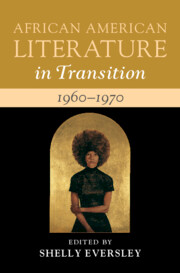Book contents
- African American Literature in Transition, 1960–1970
- African American Literature In Transition
- African American Literature in Transition, 1960–1970
- Copyright page
- Contents
- Contributors
- Preface
- Acknowledgments
- Chronology
- Introduction
- I Poetry and Music
- II Culture and Politics
- III Beyond the Canon
- Index
- References
Introduction
Black Art in Transition
Published online by Cambridge University Press: 10 November 2022
- African American Literature in Transition, 1960–1970
- African American Literature In Transition
- African American Literature in Transition, 1960–1970
- Copyright page
- Contents
- Contributors
- Preface
- Acknowledgments
- Chronology
- Introduction
- I Poetry and Music
- II Culture and Politics
- III Beyond the Canon
- Index
- References
Summary
This introductory chapter explains how, for African Americans the decade’s political disappointments and its social paradoxes also signaled a necessary transformation in culture. It details how the notion of transition, particularly as it informs understandings of poetry, prose, fiction, film, and music that emerge as important indications of the 1960s zeitgeist, and it offers an account of 1960s writers, musicians, and intellectuals who met this political moment in history with a renewed commitment to art. The period represents the moment when “Black” became a political identity, one in which social justice became inseparable from aesthetic practice. In this context, the rise of Black Power nationalism, which is often read as a radicalized version of self-defense in the face of increasing violence, features as a prominent theme to interrogate 1960s declarations of race, personal and collective empowerment, political action, and aesthetics. At the same time, however, experimentation, now a challenge to convention and a call for new ways of being and thinking, became an often overlooked, yet common artistic practice in which avant-gardes in many forms – “free jazz,” poetry, art collectives, and the novel – exposed the potentials and the contradictions that invite new evaluations and investigations.
- Type
- Chapter
- Information
- African American Literature in Transition, 1960–1970Black Art, Politics, and Aesthetics, pp. 1 - 20Publisher: Cambridge University PressPrint publication year: 2022



